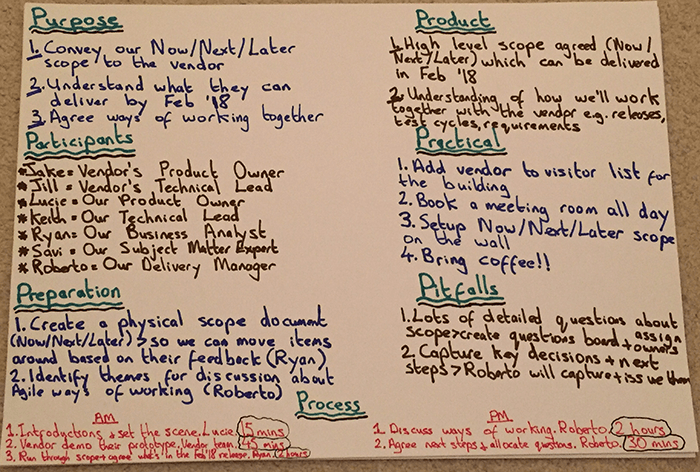Planning Workshops Using the 7Ps Technique
It’s difficult to plan for a workshop. There’s so many things to consider, sometimes it’s hard to know where to begin!
The best technique I’ve used for planning workshops is called the 7Ps. I found it in an excellent book called “Gamestorming”.
I use the 7Ps to create a clear agenda & make sure I’m prepared for a workshop.
How’s it work?
The technique asks you to consider the following areas for planning a workshop:
- Purpose – why are you having this session? I tend to write 3-4 bullet points to summarise the purpose. This is the most important question & worth starting with
- Product – what artifacts do we want to come away with from the workshop? You can think about this as outcomes or deliverables
- Process – what will the agenda be? This should tie back to the purpose. The process needs to ensure you achieve the purpose & come away with the products you want
- People – who will be in the session? And equally important – what role will they play? What kind of questions will they be there to answer? Will one person represent the technical side of the business. Will one person be there to sign-off the scope?
- Pitfalls – what are the risks of the meeting? E.g. a particular question that might blind side you, that some people will want to delve into detail. Think about these pitfalls & write down how you’ll mitigate them
- Preparation – what do you need to in advance of the session? E.g. do you need to create a presentation deck. Do you need to bring information to the meeting?
- Practical Concerns – these are things around logistics. Where’s the meeting? Do you have a TV? Who will meet the visitors etc
Working example
Below is an example of how I recently used the 7Ps.
I was planning for a workshop with a new vendor. We wanted an all day session to convey our initial requirements & allow the vendor to feedback on what they could deliver in their first release. It was also our kick-off session for agreeing how we’d work together on delivering a service.
I sketched out the below 7Ps and sent it to our team for internal feedback.

- Purpose – 3-4 bullet points felt like the right level of detail. The above purpose was what I wanted to get from the meeting; however I also considered what others / the vendor would want to get out of
it. It’s always worth thinking about other people’s expectations. I start on this section first – because that drives everything else - Product – I find this to be the hardest section. In this example the product was a collective agreement of scope & how the scope would be delivered. The product was a NOW/NEXT/LATER roadmap which would be updated in the session. Sometimes the product isn’t tangible (e.g. getting everyone to understand why you’re making a change)
- Process – this was the next section I filled in. After identifying the purpose & product, I thought about what an agenda might look like / a typical running order. Each item here contributes to the purpose – and ensures we come away with the right products. Tieing the process back the above ensures that agenda items are necessary and add value
- People – this is always really useful. Sessions shouldn’t have more than 10 people. It’s useful to think about who needs to there – and what their role with be. A role might be: to answer technical questions, to represent the product team, to answer any questions around operations, or it can be a job title
- Pitfalls – I try to think about likely pitfalls. For our session, it was that that we would be drawn into the detail, and that we’d be asked a specific process question which we didn’t know the answer to. We actually invited the SME to mititgate that pitfall. And we created a question board where very specific questions could be parked
- Preparation – who will create the assets before the workshop? What will they create & bring? I put names & deliverables in this section for our workshop
- Practical Concerns – these are often things that people forget about. For our meeting it was: booking people onsite with security, checking the room has a TV, booking a room all day so that we could setup ahead of time. This became a checklist to make sure we were ready to run the workshop
Summary
I find the 7Ps a really good technique for conducting focussed workshops.
I typically use the 7Ps on my own to create an agenda, then take a picture and get people’s thoughts. This way attendees can feedback on the agenda. I find the “Process” & “People” sections are particuarly valuable for getting feedback & co-designing an agenda.
I find creating a physical version of the 7Ps means I can cross things out & move between sections easily. I often move from one section to another – and back again – as its all interconnected.
Hopefully you found this article interesting. And it’s a technique you would consider when planning for large workshops
